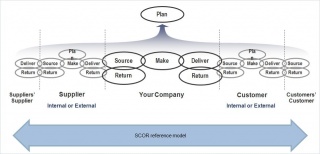Supply Chain Excellence: Series 1 – Understanding the Supply Chain
https://www.nzpics.org.nz-Vishnu Rayapeddi
Whenever we ask what supply chain is, we get different answers depending who we ask. Some say it is planning & purchasing or procurement and some say inventory management and some others may say it is logistics management. Yes all these correct answers. But there is much more!
According to APICS (Association for Operations & Supply Chain Professionals, USA) dictionary, “Supply Chain Operations Reference (SCOR®) model” is “A process reference model developed and endorsed by the Supply Chain Council as the cross-industry, standard diagnostic tool for supply chain management.
“The SCOR model describes the business activities associated with satisfying a customer’s demand, which include plan, source, make, deliver, and return. Use of the model includes analysing the current state of a company’s processes and goals, quantifying operational performance, and comparing company performance to benchmark data. SCOR has developed a set of metrics for supply chain performance, and Supply Chain Council members have formed industry groups to collect best practices information that companies can use to evaluate their supply chain performance”.
In essence, the SCOR Framework is the world’s leading supply chain framework, linking business processes, performance metrics, practices and people skills into a unified structure. By deploying the SCOR framework at your organization you can: 1) Increase the speed of system, 2) Implement Support organizational learning goals, and 3) Improve inventory turns.
Level 1 Processes included in SCOR are: Plan, Source, Make, Deliver, Return and Enable
Level 1 Metrics included in SCOR are: a) Perfect order fulfilment, b) Order fulfilment cycle time, c) Upside supply chain flexibility, d) Upside supply chain adaptability, e) Downside supply chain adaptability, f) Overall value at risk, g) Total cost to serve, h) Cash-to-cash cycle time, i) Return on supply chain fixed assets, j) Return on working capital.
So, how do we define supply chain excellence?
We can define Supply Chain Excellence in simple terms as, “Getting the right things to the right place, in the right quantities, at the right time and at the desired quality, the first time, while minimising waste and being open to embrace change.”
Objectively, Supply chain excellence is defined both by improving year-on-year financial performance and by outperforming the industry on a portfolio of metrics that correlate closely to market capitalisation. The metrics used are 1) Inventory Turns, 2) Operating Margin, and 3) Return on Invested Capital (ROIC). While we often see companies performing well in one of the three metrics, it is believed that supply chain excellence is based on the ability to drive improvement on the complete portfolio—improving all three metrics together.
About the author
This article is written by Vishnu Rayapeddi, a Lean Manufacturing & Supply Chain Operations Specialist, who works as a volunteer Executive Committee Member of NZPICS, the only Premier Channel Partner of APICS in New Zealand.
NZPICS Offers the following courses in Supply Chain in affiliation with APICS: CPIM (Certified in Production & Inventory Management, CSCP (Certified Supply Chain Professional) and Principles of Operations Management, which is a fully customisable solution to businesses. For further information, please visit www.nzpics.org.nz or call on 09-525 1525.



